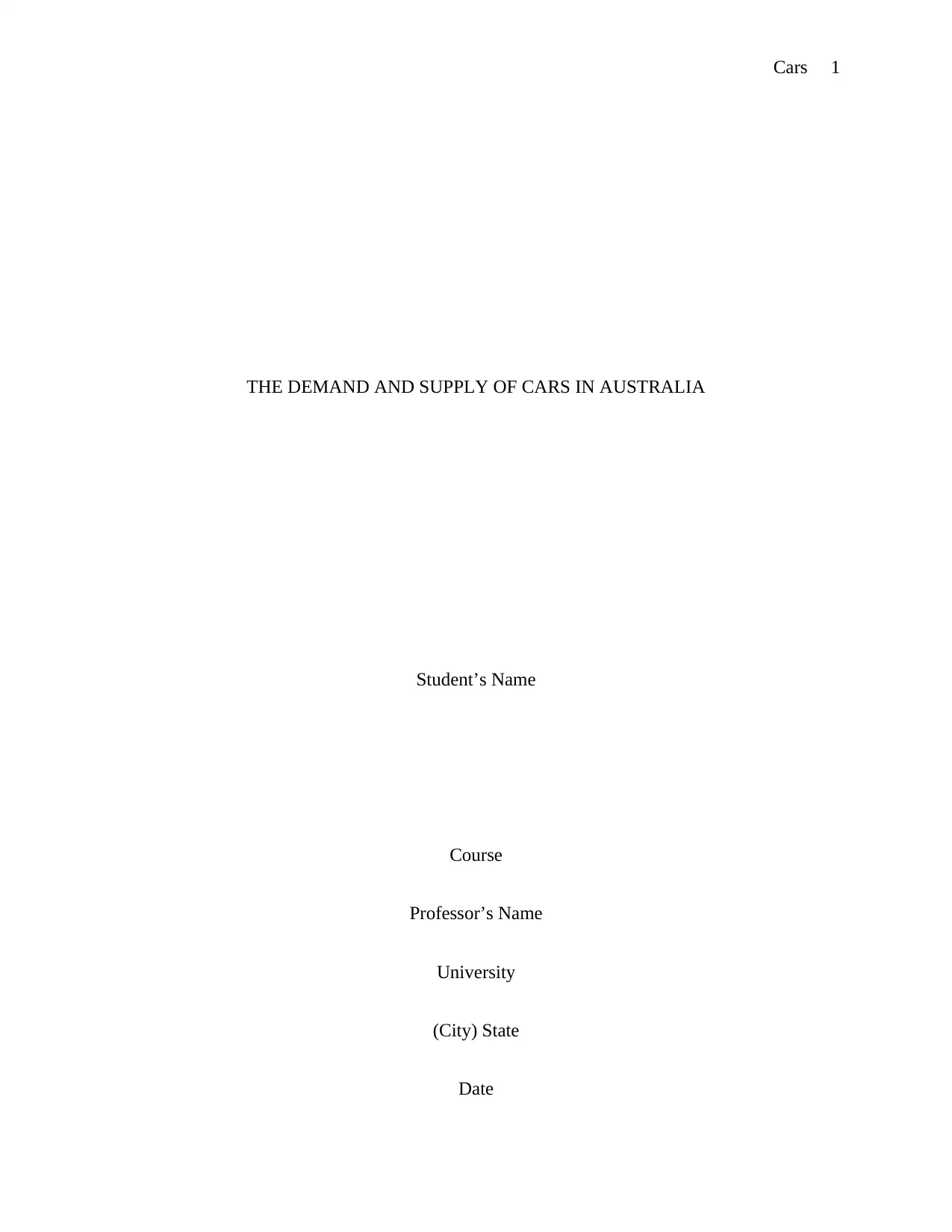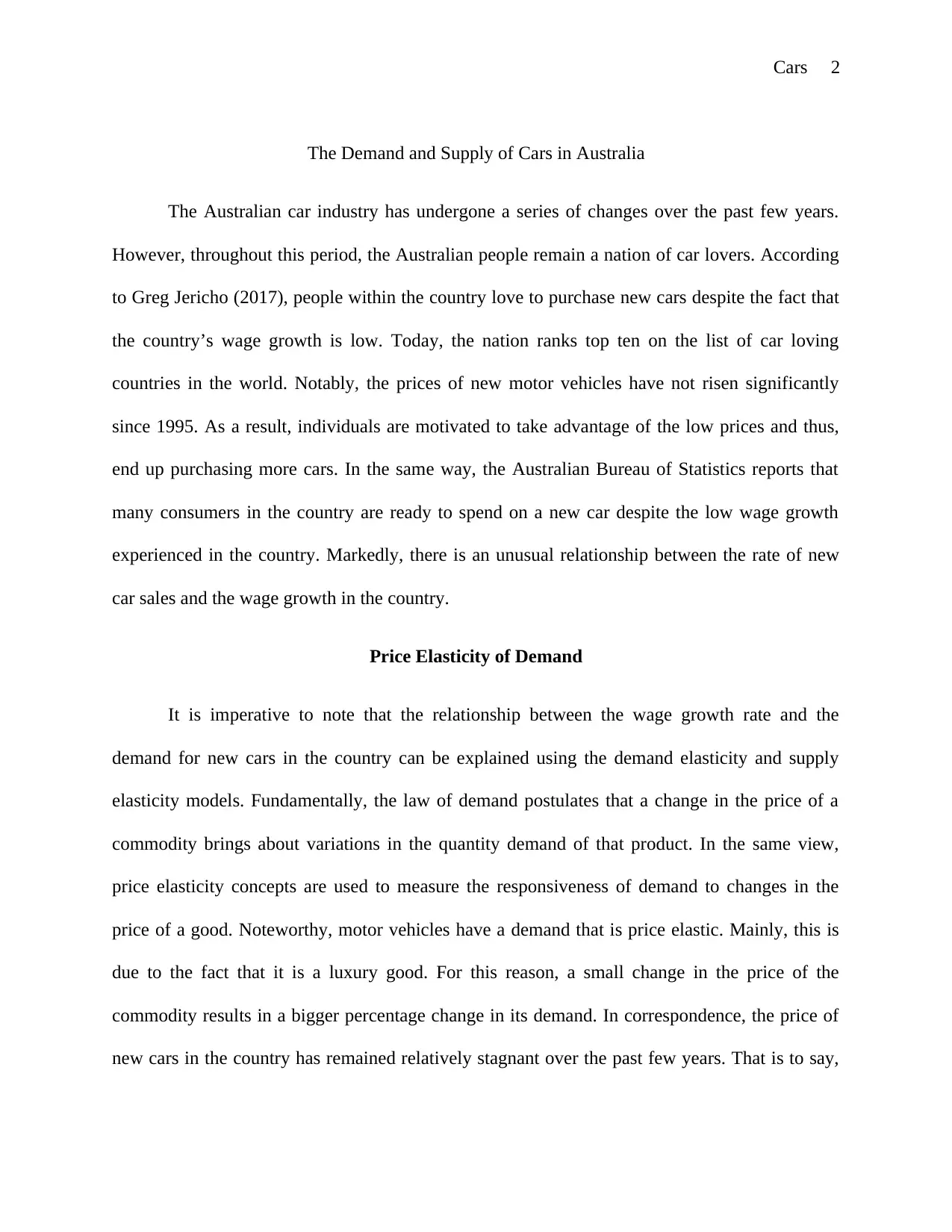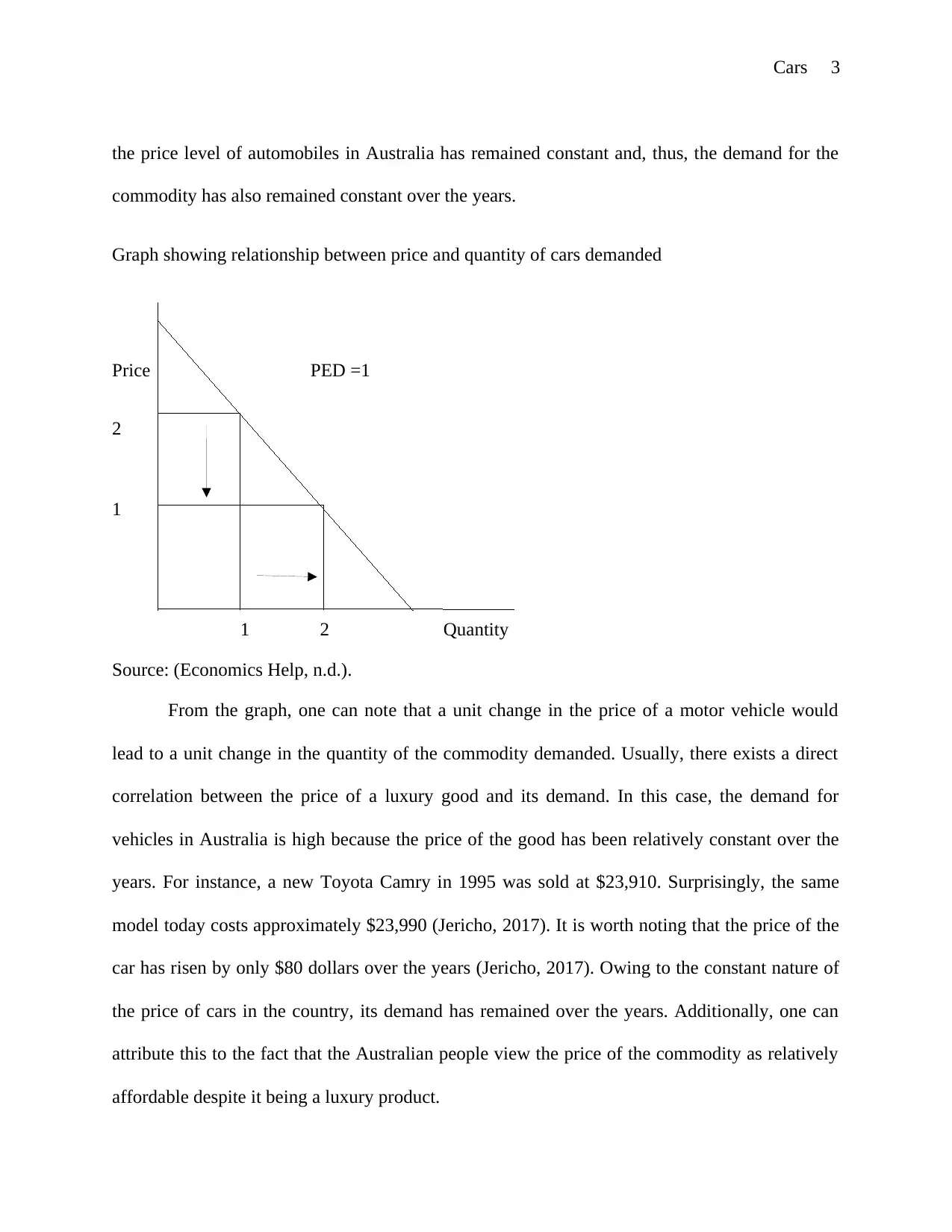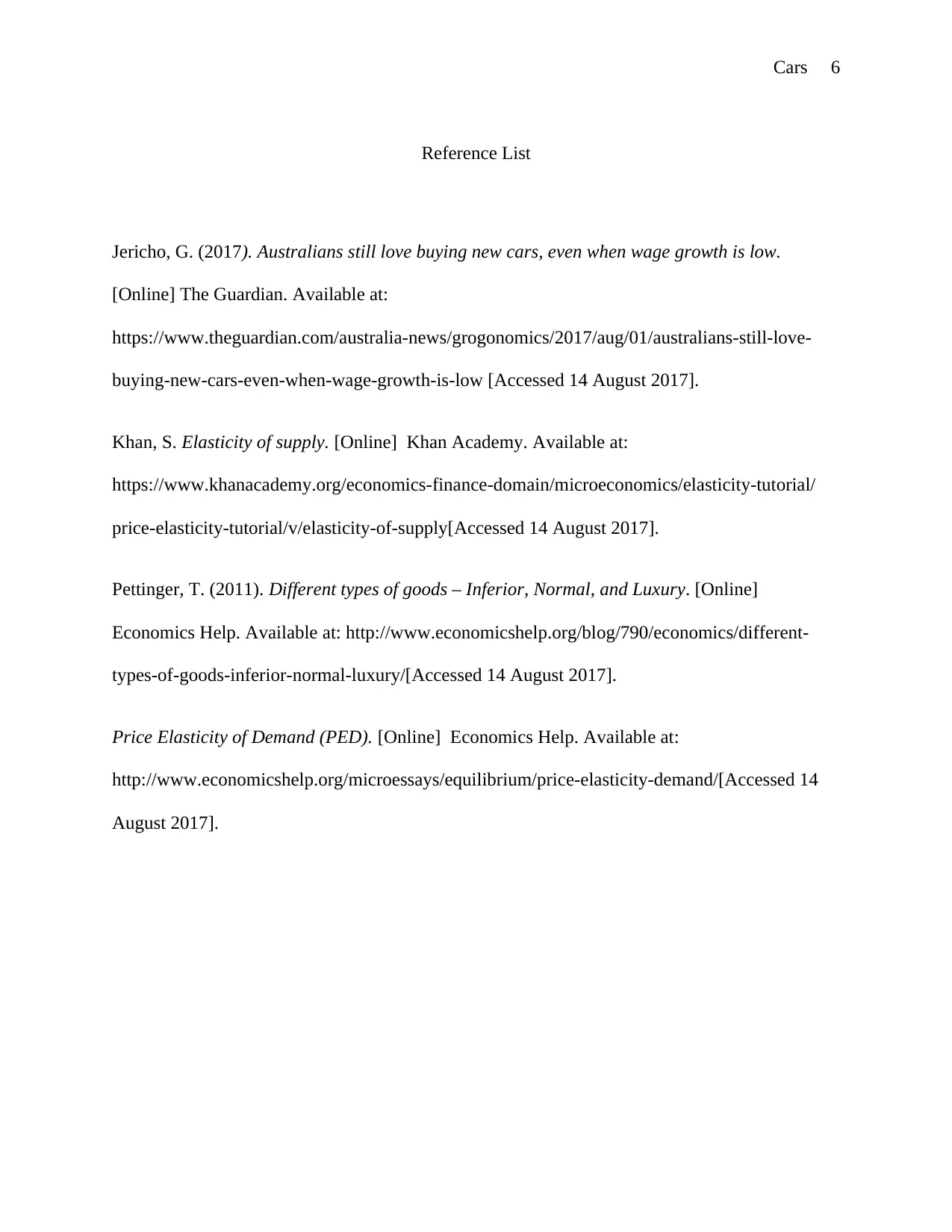The Demand and Supply Dynamics of Cars in the Australian Market
VerifiedAdded on 2020/03/04
|6
|1287
|296
Report
AI Summary
This report provides an analysis of the demand and supply of cars in Australia, exploring the factors that influence consumer behavior and market dynamics. It examines the price elasticity of demand, noting that cars are considered a luxury good, and therefore, demand is sensitive to price changes. The report also discusses the price elasticity of supply, indicating that it is relatively inelastic due to the fixed nature of raw materials. Furthermore, it delves into the income elasticity of demand, highlighting that the demand for cars increases more than proportionally with income, even in the face of low wage growth. The analysis concludes that the Australian car industry is characterized by a sustained demand for new cars, driven by a combination of factors including price stability, inelastic supply, and high-income elasticity of demand. The report uses graphs and references to support its findings, offering a comprehensive overview of the Australian car market.

Cars 1
THE DEMAND AND SUPPLY OF CARS IN AUSTRALIA
Student’s Name
Course
Professor’s Name
University
(City) State
Date
THE DEMAND AND SUPPLY OF CARS IN AUSTRALIA
Student’s Name
Course
Professor’s Name
University
(City) State
Date
Paraphrase This Document
Need a fresh take? Get an instant paraphrase of this document with our AI Paraphraser

Cars 2
The Demand and Supply of Cars in Australia
The Australian car industry has undergone a series of changes over the past few years.
However, throughout this period, the Australian people remain a nation of car lovers. According
to Greg Jericho (2017), people within the country love to purchase new cars despite the fact that
the country’s wage growth is low. Today, the nation ranks top ten on the list of car loving
countries in the world. Notably, the prices of new motor vehicles have not risen significantly
since 1995. As a result, individuals are motivated to take advantage of the low prices and thus,
end up purchasing more cars. In the same way, the Australian Bureau of Statistics reports that
many consumers in the country are ready to spend on a new car despite the low wage growth
experienced in the country. Markedly, there is an unusual relationship between the rate of new
car sales and the wage growth in the country.
Price Elasticity of Demand
It is imperative to note that the relationship between the wage growth rate and the
demand for new cars in the country can be explained using the demand elasticity and supply
elasticity models. Fundamentally, the law of demand postulates that a change in the price of a
commodity brings about variations in the quantity demand of that product. In the same view,
price elasticity concepts are used to measure the responsiveness of demand to changes in the
price of a good. Noteworthy, motor vehicles have a demand that is price elastic. Mainly, this is
due to the fact that it is a luxury good. For this reason, a small change in the price of the
commodity results in a bigger percentage change in its demand. In correspondence, the price of
new cars in the country has remained relatively stagnant over the past few years. That is to say,
The Demand and Supply of Cars in Australia
The Australian car industry has undergone a series of changes over the past few years.
However, throughout this period, the Australian people remain a nation of car lovers. According
to Greg Jericho (2017), people within the country love to purchase new cars despite the fact that
the country’s wage growth is low. Today, the nation ranks top ten on the list of car loving
countries in the world. Notably, the prices of new motor vehicles have not risen significantly
since 1995. As a result, individuals are motivated to take advantage of the low prices and thus,
end up purchasing more cars. In the same way, the Australian Bureau of Statistics reports that
many consumers in the country are ready to spend on a new car despite the low wage growth
experienced in the country. Markedly, there is an unusual relationship between the rate of new
car sales and the wage growth in the country.
Price Elasticity of Demand
It is imperative to note that the relationship between the wage growth rate and the
demand for new cars in the country can be explained using the demand elasticity and supply
elasticity models. Fundamentally, the law of demand postulates that a change in the price of a
commodity brings about variations in the quantity demand of that product. In the same view,
price elasticity concepts are used to measure the responsiveness of demand to changes in the
price of a good. Noteworthy, motor vehicles have a demand that is price elastic. Mainly, this is
due to the fact that it is a luxury good. For this reason, a small change in the price of the
commodity results in a bigger percentage change in its demand. In correspondence, the price of
new cars in the country has remained relatively stagnant over the past few years. That is to say,

Cars 3
the price level of automobiles in Australia has remained constant and, thus, the demand for the
commodity has also remained constant over the years.
Graph showing relationship between price and quantity of cars demanded
Price PED =1
2
1
1 2 Quantity
Source: (Economics Help, n.d.).
From the graph, one can note that a unit change in the price of a motor vehicle would
lead to a unit change in the quantity of the commodity demanded. Usually, there exists a direct
correlation between the price of a luxury good and its demand. In this case, the demand for
vehicles in Australia is high because the price of the good has been relatively constant over the
years. For instance, a new Toyota Camry in 1995 was sold at $23,910. Surprisingly, the same
model today costs approximately $23,990 (Jericho, 2017). It is worth noting that the price of the
car has risen by only $80 dollars over the years (Jericho, 2017). Owing to the constant nature of
the price of cars in the country, its demand has remained over the years. Additionally, one can
attribute this to the fact that the Australian people view the price of the commodity as relatively
affordable despite it being a luxury product.
the price level of automobiles in Australia has remained constant and, thus, the demand for the
commodity has also remained constant over the years.
Graph showing relationship between price and quantity of cars demanded
Price PED =1
2
1
1 2 Quantity
Source: (Economics Help, n.d.).
From the graph, one can note that a unit change in the price of a motor vehicle would
lead to a unit change in the quantity of the commodity demanded. Usually, there exists a direct
correlation between the price of a luxury good and its demand. In this case, the demand for
vehicles in Australia is high because the price of the good has been relatively constant over the
years. For instance, a new Toyota Camry in 1995 was sold at $23,910. Surprisingly, the same
model today costs approximately $23,990 (Jericho, 2017). It is worth noting that the price of the
car has risen by only $80 dollars over the years (Jericho, 2017). Owing to the constant nature of
the price of cars in the country, its demand has remained over the years. Additionally, one can
attribute this to the fact that the Australian people view the price of the commodity as relatively
affordable despite it being a luxury product.
⊘ This is a preview!⊘
Do you want full access?
Subscribe today to unlock all pages.

Trusted by 1+ million students worldwide

Cars 4
Price Elasticity of Supply
Just like demand, supply is responsive to changes in the price of a commodity.
Ordinarily, an increase in the price of a product motivates a manufacturer to supply more of the
commodity (Pettinger, 2011). Thus, when the supply of a commodity is price elastic, a small rise
in its price results in a larger than proportion rise in its supply (Economics Help, n.d.). It is
imperative to point out that the supply of motor vehicles in the country is relatively inelastic.
Thus, a big variation in the price of a car results in a small change in the quantity of the product
supplied.
Graph showing relationship between price and quantity of cars supplied
Price
4 PES
3
2
1
1 2 Quantity Demanded
Source: (Pettinger, 2011).
Fundamentally, the inelasticity of supply occurs due to the fact that raw materials used in
the production of cars are usually ‘fixed’ in supply. For this reason, it is impossible to raise the
supply of cars over the short term period despite significant changes in their prices. Besides, the
Price Elasticity of Supply
Just like demand, supply is responsive to changes in the price of a commodity.
Ordinarily, an increase in the price of a product motivates a manufacturer to supply more of the
commodity (Pettinger, 2011). Thus, when the supply of a commodity is price elastic, a small rise
in its price results in a larger than proportion rise in its supply (Economics Help, n.d.). It is
imperative to point out that the supply of motor vehicles in the country is relatively inelastic.
Thus, a big variation in the price of a car results in a small change in the quantity of the product
supplied.
Graph showing relationship between price and quantity of cars supplied
Price
4 PES
3
2
1
1 2 Quantity Demanded
Source: (Pettinger, 2011).
Fundamentally, the inelasticity of supply occurs due to the fact that raw materials used in
the production of cars are usually ‘fixed’ in supply. For this reason, it is impossible to raise the
supply of cars over the short term period despite significant changes in their prices. Besides, the
Paraphrase This Document
Need a fresh take? Get an instant paraphrase of this document with our AI Paraphraser

Cars 5
constant nature of the price of cars in Australia over the past years has ensured that
manufacturers in the country produce a consistent number of vehicles over time. Consequently,
this has ensured a continued supply of the commodity, ensuring that prices remain low.
Correspondingly, the predictable prices have ensured a relatively stable but high demand for the
commodity.
Income Elasticity of Demand
Additionally, it is useful to note that the income elasticity of demand of a commodity
plays a significant role in its demand. Indeed, the demand for motor vehicles in Australia rises
more than proportionately following changes in the wage level. As such, a small increase in the
income earned by Australians results in a large increase in the demand for the commodity. In this
regard, Jericho (2017) notes that although the wage growth in the country remains significantly
low, the demand for vehicles in the country remains high. Mainly, this can be explained by the
fact that automobiles are luxury goods and, thus, possess an income elasticity of demand of more
than one. In turn, the low wage growth does not hinder Australians from purchasing new cars.
All in all, all factors taken into consideration, the Australian motor vehicle industry is
characterized by an unending love for new cars despite the fact that the wage growth in the
country is relatively low. Primarily, the situation prevails because cars have a relatively high
price elasticity of demand. In addition, the product has a relatively inelastic price elasticity of
supply and, therefore, there is a constant supply of the commodity in the country. Moreover, the
income elasticity of demand of the product is relatively high. All these factors combined have led
to the sustained love and appreciation for new vehicles in Australia despite the low wage growth
in the country.
constant nature of the price of cars in Australia over the past years has ensured that
manufacturers in the country produce a consistent number of vehicles over time. Consequently,
this has ensured a continued supply of the commodity, ensuring that prices remain low.
Correspondingly, the predictable prices have ensured a relatively stable but high demand for the
commodity.
Income Elasticity of Demand
Additionally, it is useful to note that the income elasticity of demand of a commodity
plays a significant role in its demand. Indeed, the demand for motor vehicles in Australia rises
more than proportionately following changes in the wage level. As such, a small increase in the
income earned by Australians results in a large increase in the demand for the commodity. In this
regard, Jericho (2017) notes that although the wage growth in the country remains significantly
low, the demand for vehicles in the country remains high. Mainly, this can be explained by the
fact that automobiles are luxury goods and, thus, possess an income elasticity of demand of more
than one. In turn, the low wage growth does not hinder Australians from purchasing new cars.
All in all, all factors taken into consideration, the Australian motor vehicle industry is
characterized by an unending love for new cars despite the fact that the wage growth in the
country is relatively low. Primarily, the situation prevails because cars have a relatively high
price elasticity of demand. In addition, the product has a relatively inelastic price elasticity of
supply and, therefore, there is a constant supply of the commodity in the country. Moreover, the
income elasticity of demand of the product is relatively high. All these factors combined have led
to the sustained love and appreciation for new vehicles in Australia despite the low wage growth
in the country.

Cars 6
Reference List
Jericho, G. (2017). Australians still love buying new cars, even when wage growth is low.
[Online] The Guardian. Available at:
https://www.theguardian.com/australia-news/grogonomics/2017/aug/01/australians-still-love-
buying-new-cars-even-when-wage-growth-is-low [Accessed 14 August 2017].
Khan, S. Elasticity of supply. [Online] Khan Academy. Available at:
https://www.khanacademy.org/economics-finance-domain/microeconomics/elasticity-tutorial/
price-elasticity-tutorial/v/elasticity-of-supply[Accessed 14 August 2017].
Pettinger, T. (2011). Different types of goods – Inferior, Normal, and Luxury. [Online]
Economics Help. Available at: http://www.economicshelp.org/blog/790/economics/different-
types-of-goods-inferior-normal-luxury/[Accessed 14 August 2017].
Price Elasticity of Demand (PED). [Online] Economics Help. Available at:
http://www.economicshelp.org/microessays/equilibrium/price-elasticity-demand/[Accessed 14
August 2017].
Reference List
Jericho, G. (2017). Australians still love buying new cars, even when wage growth is low.
[Online] The Guardian. Available at:
https://www.theguardian.com/australia-news/grogonomics/2017/aug/01/australians-still-love-
buying-new-cars-even-when-wage-growth-is-low [Accessed 14 August 2017].
Khan, S. Elasticity of supply. [Online] Khan Academy. Available at:
https://www.khanacademy.org/economics-finance-domain/microeconomics/elasticity-tutorial/
price-elasticity-tutorial/v/elasticity-of-supply[Accessed 14 August 2017].
Pettinger, T. (2011). Different types of goods – Inferior, Normal, and Luxury. [Online]
Economics Help. Available at: http://www.economicshelp.org/blog/790/economics/different-
types-of-goods-inferior-normal-luxury/[Accessed 14 August 2017].
Price Elasticity of Demand (PED). [Online] Economics Help. Available at:
http://www.economicshelp.org/microessays/equilibrium/price-elasticity-demand/[Accessed 14
August 2017].
⊘ This is a preview!⊘
Do you want full access?
Subscribe today to unlock all pages.

Trusted by 1+ million students worldwide
1 out of 6
Related Documents
Your All-in-One AI-Powered Toolkit for Academic Success.
+13062052269
info@desklib.com
Available 24*7 on WhatsApp / Email
![[object Object]](/_next/static/media/star-bottom.7253800d.svg)
Unlock your academic potential
Copyright © 2020–2025 A2Z Services. All Rights Reserved. Developed and managed by ZUCOL.




